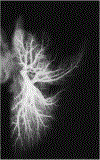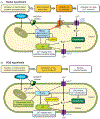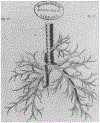Lung Circulation
- PMID: 27065170
- PMCID: PMC7432532
- DOI: 10.1002/cphy.c140049
Lung Circulation
Abstract
The circulation of the lung is unique both in volume and function. For example, it is the only organ with two circulations: the pulmonary circulation, the main function of which is gas exchange, and the bronchial circulation, a systemic vascular supply that provides oxygenated blood to the walls of the conducting airways, pulmonary arteries and veins. The pulmonary circulation accommodates the entire cardiac output, maintaining high blood flow at low intravascular arterial pressure. As compared with the systemic circulation, pulmonary arteries have thinner walls with much less vascular smooth muscle and a relative lack of basal tone. Factors controlling pulmonary blood flow include vascular structure, gravity, mechanical effects of breathing, and the influence of neural and humoral factors. Pulmonary vascular tone is also altered by hypoxia, which causes pulmonary vasoconstriction. If the hypoxic stimulus persists for a prolonged period, contraction is accompanied by remodeling of the vasculature, resulting in pulmonary hypertension. In addition, genetic and environmental factors can also confer susceptibility to development of pulmonary hypertension. Under normal conditions, the endothelium forms a tight barrier, actively regulating interstitial fluid homeostasis. Infection and inflammation compromise normal barrier homeostasis, resulting in increased permeability and edema formation. This article focuses on reviewing the basics of the lung circulation (pulmonary and bronchial), normal development and transition at birth and vasoregulation. Mechanisms contributing to pathological conditions in the pulmonary circulation, in particular when barrier function is disrupted and during development of pulmonary hypertension, will also be discussed.
Copyright © 2016 John Wiley & Sons, Inc.
Figures









Similar articles
-
Physiological aspects of high-altitude pulmonary edema.J Appl Physiol (1985). 2005 Mar;98(3):1101-10. doi: 10.1152/japplphysiol.01167.2004. J Appl Physiol (1985). 2005. PMID: 15703168 Review.
-
[Treatment of acute pulmonary hypertension caused by hypoxia--cosmetic or clinical benefits?].Schweiz Med Wochenschr. 1994 Feb 19;124(7):274-81. Schweiz Med Wochenschr. 1994. PMID: 8134806 French.
-
Altered Redox Balance in the Development of Chronic Hypoxia-induced Pulmonary Hypertension.Adv Exp Med Biol. 2017;967:83-103. doi: 10.1007/978-3-319-63245-2_7. Adv Exp Med Biol. 2017. PMID: 29047083
-
Endothelial and smooth muscle cell ion channels in pulmonary vasoconstriction and vascular remodeling.Compr Physiol. 2011 Jul;1(3):1555-602. doi: 10.1002/cphy.c100023. Compr Physiol. 2011. PMID: 23733654 Free PMC article. Review.
-
NO in the lung.Respir Physiol. 1995 Aug;101(2):109-20. doi: 10.1016/0034-5687(95)00016-7. Respir Physiol. 1995. PMID: 8570913 Review.
Cited by
-
Biomarkers in idiopathic pulmonary fibrosis: Current insight and future direction.Chin Med J Pulm Crit Care Med. 2024 Jun;2(2):72-79. doi: 10.1016/j.pccm.2024.04.003. Epub 2024 Jun 14. Chin Med J Pulm Crit Care Med. 2024. PMID: 38962100 Free PMC article.
-
The pulmonary vasculature in lethal COVID-19 and idiopathic pulmonary fibrosis at single-cell resolution.Cardiovasc Res. 2023 Mar 31;119(2):520-535. doi: 10.1093/cvr/cvac139. Cardiovasc Res. 2023. PMID: 35998078 Free PMC article.
-
Vascular Reactions of the Diving Reflex in Men and Women Carrying Different ADRA1A Genotypes.Int J Mol Sci. 2022 Aug 21;23(16):9433. doi: 10.3390/ijms23169433. Int J Mol Sci. 2022. PMID: 36012699 Free PMC article.
-
Characterization of Contractile Machinery of Vascular Smooth Muscles in Hypertension.Life (Basel). 2021 Jul 16;11(7):702. doi: 10.3390/life11070702. Life (Basel). 2021. PMID: 34357074 Free PMC article. Review.
-
Diabetic microvascular disease in non-classical beds: the hidden impact beyond the retina, the kidney, and the peripheral nerves.Cardiovasc Diabetol. 2023 Nov 15;22(1):314. doi: 10.1186/s12933-023-02056-3. Cardiovasc Diabetol. 2023. PMID: 37968679 Free PMC article. Review.
References
-
- Abe K, Shimokawa H, Morikawa K, Uwatoku T, Oi K, Matsumoto Y, Hattori T, Nakashima Y, Kaibuchi K, Sueishi K, Takeshit A. Long-term treatment with a Rho-kinase inhibitor improves monocrotaline-induced fatal pulmonary hypertension in rats. Circ Res 94: 385–393, 2004. - PubMed
-
- Abe K, Toba M, Alzoubi A, Ito M, Fagan KA, Cool CD, Voelkel NF, McMurtry IF, Oka M. Formation of plexiform lesions in experimental severe pulmonary arterial hypertension. Circulation 121: 2747–2754, 2010. - PubMed
-
- Abe T, Arakawa Y, Rajasekaran AK, Yu TH, Wada O. Interaction of atrial natriuretic peptide with its receptors in bovine lung membranes. J Biol Chem 270: 7672–7678, 1995. - PubMed
-
- Abman SH, Accurso FJ. Acute effects of partial compression of ductus arteriosus on fetal pulmonary circulation. Am J Physiol 257: H626–H634, 1989. - PubMed
Publication types
MeSH terms
Grants and funding
LinkOut - more resources
Full Text Sources
Other Literature Sources
Medical
Research Materials

